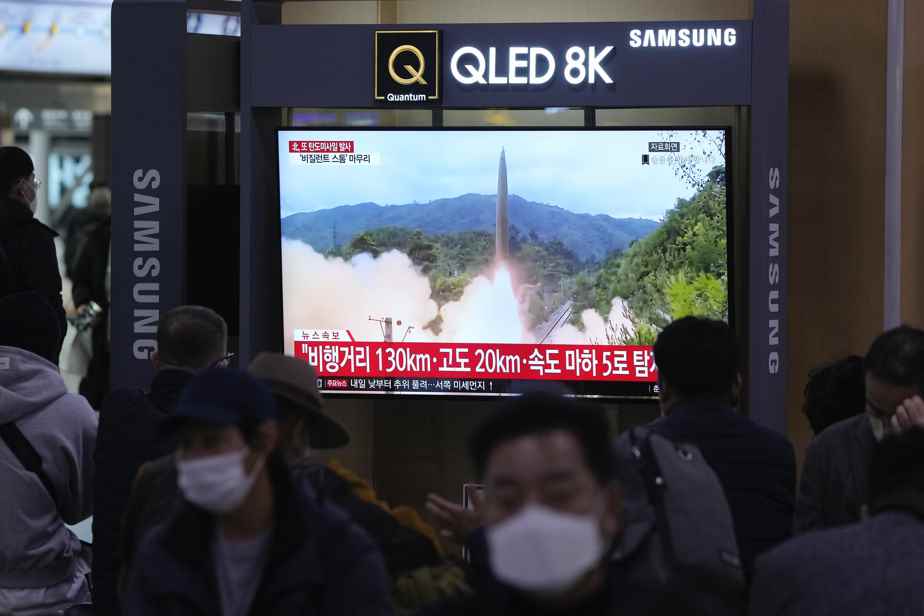(SEOUL) North Korea launched four short-range missiles toward the Yellow Sea on Saturday, following a record series of launches this week, in response to joint aerial maneuvers conducted by South Korea and the United States all week.
Posted at 7:27
Pyongyang had called the “Vigilant Storm” exercise an “aggressive and provocative military maneuver targeting the Democratic People’s Republic of Korea”, threatening Seoul and Washington to “pay the most horrible price in history”.
South Korea’s military detected the launch on Saturday “from Donglim, North Pyongang province, to the Western Sea (Korean name for the Yellow Sea), between 11:32 a.m. (10:32 p.m. EDT) and 11:39 a.m. of four missiles.
Their “flight distance was detected at some 130 km, at an altitude of approximately 20 km and a speed of Mach 5” (five times the speed of sound, editor’s note), adds the press release.
Shortly before, the South Korean army had announced the participation on Saturday afternoon in the “Vigilant Storm” exercises of the American supersonic heavy bomber B-1B.
“The South Korean and American air forces conducted joint exercises on November 5 (Saturday) on the Korean peninsula with two American air force B-1Bs, four South Korean F-35As and four American F-16s,” according to a statement from the South Korean general staff at the end of the maneuvers on Saturday afternoon.
Significant threat
The B-1B is a supersonic bomber that the United States Air Force describes as the “backbone of America’s long-range bomber force.”
Its deployment is considered by Pyongyang as a “significant threat”, Ahn Chan-il, an expert on North Korean issues, told AFP.
“Watchful Storm,” which kicked off on Oct. 31, is the largest series of maneuvers ever jointly organized by South Korea and the United States.
Originally scheduled until Friday, the exercises have been extended until Saturday after North Korea has increased its missile strikes in recent days, including the apparently failed launch of an intercontinental ballistic missile (ICBM) in the direction of the Sea of Japan.
North Korea has always viewed U.S.-South Korean military maneuvers as dress rehearsals for an invasion of its territory or an overthrow of its rulers.
And aerial maneuvers particularly worry him, because his air force is one of the weakest points of his army, lacking both the latest technology planes and experienced pilots.
Although it was originally designed to carry nuclear weapons, the B-1B has only been used by the United States for exclusively conventional combat missions since the mid-1990s, indicates its manufacturer Boeing on its site. Internet. It was notably used in Iraq, Afghanistan and Libya.
It can carry up to 34 tons of missiles or laser-guided bombs (BGL), according to the US Airforce. Its air supply allows it to strike anywhere in the world.
On Friday evening, the South Korean army announced that it had deployed some 80 F-35A stealth aircraft after detecting 180 fighter jets flying in North Korean airspace, a new episode in the spectacular rise in tension on the Korean peninsula in recent times. last weeks.
Disagreement at the UN
The United States denounced on Friday the firing of North Korean missiles which “ridiculously ridicule” the UN Security Council, with the complicity according to them of Russia and China, allies of Pyongyang.
After attacking Russia and China, Washington, Paris, London and other non-permanent member states of the Security Council advocated in a joint statement “unity” in the face of the “threat that Korea of the North stands for international peace”.
UN Secretary General Antonio Guterres said he was “deeply concerned about the tensions on the Korean peninsula and the rise of confrontational rhetoric”, according to his spokesman Stéphane Dujarric.
Pyongyang fired about 30 missiles on Wednesday and Thursday, including one that ended its course near southern territorial waters for the first time since the end of the Korean War in 1953. South Korean President Yoon Suk-yeol spoke of a “de facto territorial invasion”.
Analysts attribute Pyongyang’s particularly angry reaction to the use of advanced F-35A and F-35B stealth aircraft during “Vigilant Storm”, seen as an ideal tool for carrying out lightning “decapitation strikes” against North Korean leaders.
North Korea had already, in September, revised its nuclear doctrine to allow itself to carry out preventive strikes in the event of an existential threat against the Kim Jong-un regime.
If North Korea’s nuclear “command and control system” is “endangered by an attack by hostile forces, a nuclear strike will be launched automatically and immediately,” the new doctrine says.
